(emTech) Section Plus
(emTech) Section Plus is about providing “more” content on emerging technologies—the primary topic of the Xpresso newsletter. This deeper version of (emTech) is provided exclusively for annual subscribers of architosh INSIDER Membership.
Special Feature
We published a special feature in Xpresso 21 titled, Bentley’s Now Public — YII20 Highlights and Re-Attacking the Architecture Market
BENTLEY’S YEAR IN INFRASTRUCTURE 2020 was held virtually this year, following the pattern held by almost all conferences due to the global pandemic. In this article, we want to cover two primary themes, the first being a general summary of highlights on this year’s YII2020 conference and, secondly, a discussion about how Bentley aims to re-engage with architects in the BIM market with its OpenBuildings Designer platform.
We believe that this is a good opening for us to tackle that again with the architects.
Bentley knows from their own award program that their Microstation-based products like OpenBuildings Designer can handle massive projects on the performance front. This is why it has been successful in large infrastructure, whether that infrastructure is vertical or horizontal. “So we need to focus on the larger practices,” said Trierscheid. “They need to feel our rekindling of focus on building and modeling again.”
To read the full story, click here to Xpresso #21. You can subscribe to Xpresso here, it’s free!
The Top Ten Must-Reads
I’ve combed the Internet to find the most interesting, compelling, or controversial stories about the AEC and manufacturing industries, and the social and emerging technological forces at play on both:
1 – Gensler launches Blox, an algorithm-powered design visualization, and computational platform. Nobody should be surprised to hear that a global AEC design giant like Gensler is launching a new digital design platform. The new tool is called Blox and is part of the firm’s inFORM suite of “internally developed proprietary products” created just for Gensler, just to propel the architecture firm’s overall practice abilities. (LinkedIn Pulse)
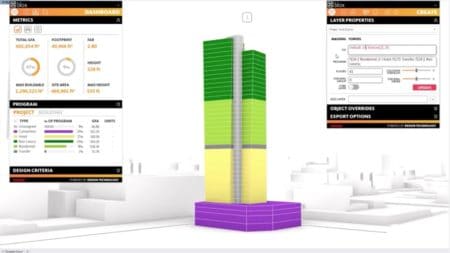
A proprietary computational design platform has been created at Gensler. You can see Gensler’s Blox in action in the video below.
What has Gensler said to explain this? This is important for a range of reasons. Joseph Joseph, partner and global technology director, design technology studio, Gensler, writes that, “We believe that our craft as designers is founded on these superpowers that are innately human and irreplaceable by technology. As such, we believe that we stand to gain significantly by combining our human superpowers with computing cognition to achieve infinite possibilities thus elevating our value to a much higher purpose in the world.”
You can watch the action here below:
2 – Positioning computational designers in your business: 4 things to consider. We came across this series of articles from Nathan Miller of Proving Ground via a newsletter from Building Design + Construction. Miller starts by making the point that there is little industry consensus about what a “computational designer” position actually is. He provides guidance, which is useful for any architect in a leadership role trying to figure out if adding this title or role in their firm is of value. (BD+C)
What’s the skinny? Computational design is not a technical role, Computational design is not equal to BIM. Computational design is not for everyone! Computational design equals solutions. This is an interesting high-level read of the issues around this role.
3 – Meet JAILBOT, Hilti’s new construction robot. Construction industry toolmaker Hilti has introduced a new robot for construction, specifically for MEP work. The robot is a complete, self-contained, software, and hardware system that works semi-autonomously. It specifically is good at the layout and drilling of holes on the underside of floors above for anchoring suspended systems like HVAC ductwork, wire management trays, and suspended ceilings. (BD+C)
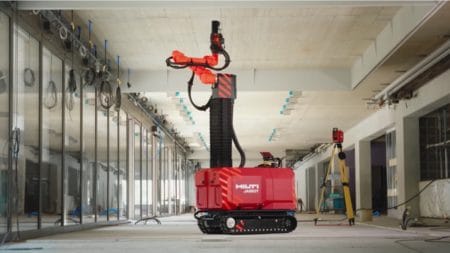
Another specific-task construction robot, this one from Hilti. JAILBOT drills holes in ceiling situations like this one pictured, speeding up the work, increasing accuracy, and human safety. (Image: screengrab, YouTube video.)
Why is this important? These systems require 3D spatial data in order to work, placing the emphasis on the usefulness of BIM models and their data in the overall AEC workflow process. The robot can drill with greater speed, accuracy, and safety, allowing human labor on the job site to focus their efforts on other tasks. JAILBOT works after data has been uploaded from Autodesk Revit or AutoCAD files to the Hilti Cloud. The robot comes with a rugged field tablet—which appears to be a tiny tablet running Microsoft Windows. Watch the video of this robot here.
4 – Meet the world’s newest architects: algorithms. This article from the World Economic Forum (WEF) brings to the attention of its global intellectual audience, the changing state of design in the field of architecture. (WEF)
What matters? This article from summer actually does a decent overview of the role algorithms-aided design (AAD) technology is playing in the field. It doesn’t get into tools but has some interesting links, such as this one on Introduction to Ant colony optimization (ACO).
5 – Biomimicry enables architects to make a “positive impact” on the environment… says Exploration Architecture founder Michael Pawlyn. (Dezeen)
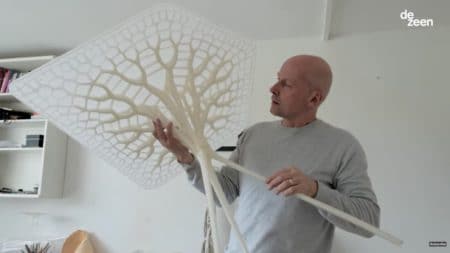
Architect Michael Pawlyn holding up a segment of architecture inspired by biomimicry. (Image: screengrab, YouTube video.)
What is biomimicry? Biomimicry is innovation inspired by nature. It involves looking at nature to understand how things work and can inspire architects and engineers to design more efficiently using morphological formations more similar to what we find in such things as trees, plants, and shells.
6. Covid-19 challenges New York’s future. This excellent article over at the Economist (from June) discusses how Covid-19 has impacted New York City. A quote: “By night, Manhattan holds 1.6m souls, a large number for a small island. In the morning over twice as many more rush in like a tide, filling up office blocks, coffee shops and spin classes. In the evening this tide drains back out over bridges and through tunnels, leaving just a thin residue of small-hours stop-outs and shift workers. The ebb and flow is shallower at weekends and in summer. But it has held its rhythm for more than a century.” (Economist)
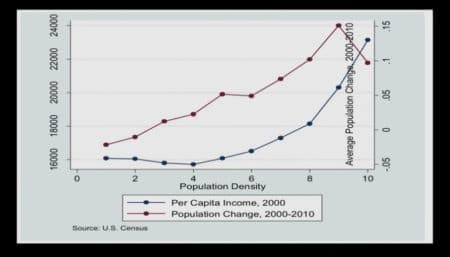
Edward Glaeser’s charting of wealth (per cap income) as it relates to density. Urban density increases human production efficiency which leads to higher GDP for denser places to live. In effect, cities are functioning like microprocessors. (see analysis below).
What impact did Covid have? By mid-march, the ebb and flow of people coming into New York City stopped. So instead of a daily rush of 1.6m + additional souls coming into the city every day, practically zero new souls came into the city during the day. What an impact change. New York City generates USD 1.8 trillion GDP every year. Edward Glaeser, an economist at Harvard University, has shown that urban density is good for the planet. It decreases our carbon footprint while increasing workers’ productivity. So cities are like highly efficient microprocessors. Like microchips, the tighter you get people together the faster they can make “production” of all sorts happen, and with less energy.
7 – Digital Twins to play a bigger role in post-pandemic construction. Digital twin technologies will make it possible for building owners to design and build for maximum social distancing and various scenarios. (Construction Dive)
How? A digital twin is more than just a BIM model. It includes all kinds of data about how a building is used, what times people fill the spaces inside, how packed spaces get, what rooms are used and which ones are not, how humans fill circulation paths, etc. Pedestrian traffic simulation software like Bentley’s LEGION is one such solution solving for social distancing as a criterion now in the age of Covid-19.
8 – New School of Design degree focuses on using robotics in architecture. One of the US’s top colleges for design, Penn’s Stuart Weitzman School of Design will offer a new master’s degree (started this fall) called Master of Science in Design: Robotics and Autonomous Systems (MSD-RAS). (Daily Pennsylvanian)
I think what’s really important is to work on the role of the architect: to get out of the corner that is only designer. Ten percent of the role is to design and 90% is realizing the design.
Why it matters? Penn’s new program will be one of the few architecture programs in the United States that use robots and artificial intelligence in design. The master’s degree requires ten courses and can be completed in nine months.
9. An Overview of Digital Fabrication in Architecture. This article from last month at ArchDaily captures some of the content we have brought to Xpresso many months ago, but it is worth bringing up because this article is a deep dive into the topic of digital fabrication in architecture, in general. (ArchDaily)
Why it matters? This article covers the various “areas” of digital fabrication in architecture. From Additive Manufacturing to Subtractive Manufacturing, to Automated Construction Processes, etc, this article gives a snapshot of each area.
10 – Humanity is stuck in short-term thinking. Here’s how we escape. Here is a quote from this excellent article by Richard Fisher: “Just as children expand their temporal perceptions as they age, so too has our species over millennia. Like toddlers, our pre-human ancestors had no sense of a distant future. They lived only in the present. Humanity’s trajectory from tool-wielding hominins to the architects of grand metropolises has been interwoven with our ever-expanding sense of time. Unlike other animals, we have minds capable of imagining a deep future, and we can conceive the daunting truth that our lifetime is a mere flash in an unfathomable chronology. (Technology Review)
Why is it difficult to escape? Fisher explains that part of our 21st-century ills is this very dangerous short-termism—driven by a world saturated in media across all kinds of screens, the dailyness of social media, and the difficulty of getting beyond our next news cycle. He argues we have become stuck in the “now.” Is this why, perhaps, American put a reality TV star into the White House, because he was the right person to keep them focused on the day, the now, rather than on looking and building for the future?
This short-terminism is taking our eye off the necessity of taking care of our planet and its precious resources…off making the necessary changes to address long-term human sustainability. We have become the antithesis of the medieval builders of cathedrals, those often lauded for their long-term thinking for creating structures that would last centuries and generations far beyond them.
Curated content: Emerging Technologies and their potential impact on CAD-based industries
Siemens and Parasolid: Apple Sillicon
In the last issue, we said we had something special coming up that delved into Apple Silicon-based Macs (ARM Macs) and the CAD markets. Just about three weeks ago when we took that article to the company from which the interview came, they said something had changed between the months when we last spoke and now and that we could not publish it. Instead, they said, “hold off another two weeks and things will become more clear.” In fact, they wanted us to come back in two weeks and do another interview because they had new news.
A week later, Apple announced its “One more thing” event.
I won’t say any more about that particular unnamed company but another part of our planned Special Feature for this issue of Xpresso was our discussions with Seimens about Parasolid and Apple Silicon. What follows below are some highlights from my discussion in the summer with Phil Nanson, Manager, Parasolid Components, Siemens PLM Software, where he is located in Cambridge, United Kingdom.
We had an extensive discussion. We will just jump into some of it below:
(Xpresso) What was it like in terms of investment time to build out Parasolids for Apple’s iOS platform and how might that relate to the effort to transition support for Parasolid for macOS on Apple Silicon?
(Phil Nanson, Siemens) iOS was a harder port but not our hardest. Most of our challenges were in testing rather than getting Parasolid to run. Obviously, supporting so many customers we do a lot of automated testing. Currently, we are running 90,000 tests a night on the iOS platform. We run about 4 million tests a night across all platforms and builds. Getting all that infrastructure to work in the very different environment of a tablet where there is a whole different set of assumptions to the usage model and productivity…that’s where the main cost was.
So infrastructure we could then reuse very easily when it came to supporting Android because a lot of the problems are the same. And I would expect Apple’s ARM Macs would be easier, one that that is more likely to follow the paradigms of a desktop.
Further Analysis & Commentary: So the challenges for the modeling kernel on other operating systems aren’t just about differences among chip architectures but very much also about how devices are used and how that impacts usage models at the point of interface with software. This impacts testing infrastructure. Apple ARM-Macs will be used like all Macs today are used. We don’t see Apple making their new Macs hybrids with touch screen interfaces. Such a move makes them iPads. Instead, we see the Touch Bar and the touch-based functions of the Track-Pad as being the only areas where new challenges for the Parasolid modeling kernel may come up.
So at this point, you have completely supported Parasolid on other ARM-based platforms?
Yes. They are supported on Apple’s iOS and Google Android.
Those 90,000 tests per night on iOS, do they include actually testing CAD applications as part of your tests?
Our general tests include CAD applications. We don’t do that on iOS but we do it on Linux and platforms with heavy service. Our standard tests include all the project tests we’ve written. And we are normally testing all the PRs anyone’s ever submitted to us. We try to have a combination of testing the things that are developed in QA and testing anything anyone has ever found as an issue.
Further Analysis & Commentary: We can safely assume iOS developers doing CAD/3D pro apps have submitted issues and these are being tested regularly as part of standard tests.
(Xpresso) Apple offered developers the opportunity to acquire ARM-based Macs in the form of Mac minis for testing. Is Parasolid in possession of one of those machines?
(Phil Nanson, Siemens) We are expecting to be in possession soon. (Editor’s note. this was back in July when we spoke.)
When you did your iOS version of Parasolid, what was the general duration of time to port Parasolid?
I think it took us 6-9 months. That was one of our harder ports because of the infrastructure changes.
If it took you the same time with Macs on Apple Silicon, it would probably put you in a really good position.
We are targeting the point of production, early next year.
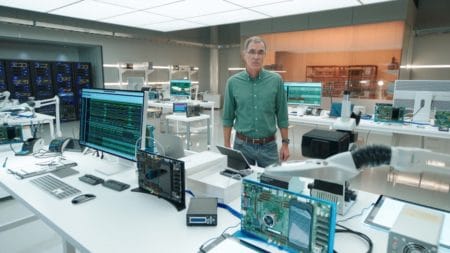
Tim Millet, VP Platform Architecture, Apple, inside an Apple Lab focused on Apple Silicon. (Image: screengrab from Apple Event in September)
Do you have any sense of the CAD industry, in general, moving to ARM architecture platforms? You have said you see a greater interest in tablets. Do you also see a greater interest in CAD in the data center, where people can access these machines through virtual desktops?
I believe it will be completely driven by performance and price. The effect of that transition will make people much more agnostic because the machines won’t be sitting in front of them. People are more likely to switch more quickly and dramatically than when they have to invest in the hardware. So it definitely increases the likelihood people will switch.
Further Analysis & Commentary: On this last question, what I am driving at is will ARM-based workstations (remember Apple’s Mac Pro will likely be the first) placed in the cloud enable greater switching between platforms? If ‘CAD tool A’ is new and written for Apple Silicon Macs and a user is considering it, would it be easier to consider switching if it was available in cloud computing form? Phil is making the point, which I agree with, that depending on cost and performance, if they don’t have to invest in the hardware it can definitely increase their likelihood of switching. One hopes then that Apple fully supports its new ARM-based Macs to be used in data centers for robust support for virtualized application serving. This can enable fluidity in the software market giving developers more incentive to enable ways for potential customers to try their new apps.
A SketchUp Killer? Meet Snaptrude from India
Architosh was recently contacted by a new company out of India. Meet, Snaptrude.
Snaptrude is a cloud-based concept design tool that aims to close the gap between design phase work and BIM phase work. Quoting their website, “With Snaptrude Architects can literally squeeze the mundane manual tasks of hours into a few minutes on a single platform on the cloud.”
The company is very new and we hope to go through a demo with the company’s CEO, Altaf Ganihar very soon. Ganihar is a mathematics genius and realized the problems architects were facing while a young scholar working in the field of computer graphics and machine learning in 2014. He was surprised to learn how real architects and designers actually work, how fragmented and tedious the existing design process actually is.
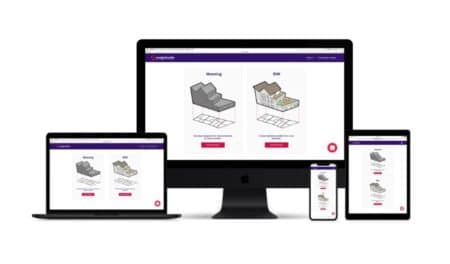
Snaptrude is cloud-based and can run on multiple device types as shown here in this image. (Image: screengrab: Snaptrude.com)
The goal of Snaptrude is to change this, to introduce new technologies that allow for seamlessness in the design process.
Further Analysis & Commentary: On the surface—and again we have yet to actually engage with this new tool—Snaptrude looks similar to SketchUp in its web version, but clearly there is much more going on here from the visuals seen on the company’s website. What is enchanting about its main graphics is that the design process begins with a napkin sketch, then a photo of the napkin sketch, then it finds its way in Snaptrude from where the design process accelerates from rough concept modeling to the beginnings of a 3D architectural model with wall thicknesses and openings and then furniture and data appear.
Evan Troxel Talk:
Architect Evan Troxel, of the TRXL Podcast, which focuses on how technology is changing the architectural profession, has released a video recorded talk he gave at HMC Architects, of Ontario, California. This has actually been up since March of this year but I wanted to bring this to your attention because it fits squarely on the emerging technologies (emTech) focus of the Xpresso newsletter.
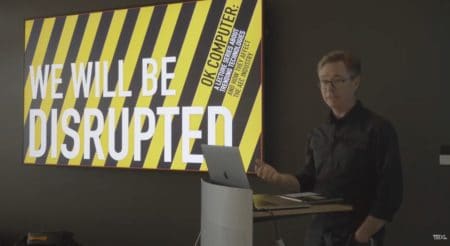
Architect Evan Troxel, Director of Digital Practice, HMC Architects, and creator and host of the podcast TXRL presenting a talk on disruption in Architecture. (Image: screengrab)
The topic of his talk is “Disruption.” Really about how technology is disrupting the field AEC fields and in this case how technology can disrupt the field and profession of architecture.
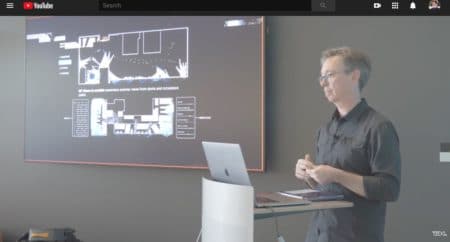
Architect Evan Troxel, Director of Digital Practice, HMC Architects, and creator and host of the podcast TXRL presenting a talk on disruption in Architecture. (Image: screengrab)
Evan goes over what defines technology “disruption” using Clayton Christensen’s definition from his book “The Innovator’s Dilemma: When New Technologies Cause Firms to Fail (Management of Innovation and Change).” Evan also mentions “The Future of the Professions: How Technology Will Transform the Work of Human Experts,” by Richard and Daniel Susskind. These are both books I have read and worth re-reading, in fact, and Evan does a great job of going through examples of disruption and looking at a range of newcomers in AEC that could be disruptive. To watch his talk go here and check out the video on YouTube.
You can learn more about Evan and hear his superb podcast series, TRXL. here.
Issue Index
I have mentioned the following companies and solutions in this issue (see above):
Bentley OpenBuildings Designer
Penn Master of Science in Design: Robotics and Autonomous Systems (MSD-RAS)
The Innovator’s Dilemma: When New Technologies Cause Firms to Fail
Closing Notes
We are still working on our introduction of version 1.0 of our Xpresso Reader Glossary and Index. It turned out to be a big project. It will make a nice seasonal Holiday Gift!
What did Architosh INSIDER members Get?
Member Access—(emTech) Section Plus articles like this one provide architosh INSIDER annual subscribers with more of the content in the (emTech) section of our free monthly newsletter. While this article above features much of the latest issue of Xpresso (#21), there are more and deeper Further Analysis and Commentary sections, more inline videos, and an issue index with links—just for annual INSIDER member subscribers like you.
In addition, the Top Ten Must Reads actually feature 10 curated stories with our commentary and analysis of why we selected them. In Xpresso, only five are provided.
Member Access articles are a premium bonus to annual subscribers that add to the “unlimited site access” nature of your subscription. Thanks for subscribing!

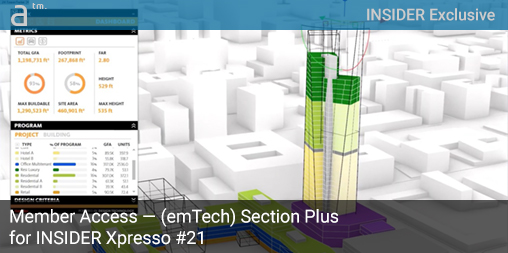
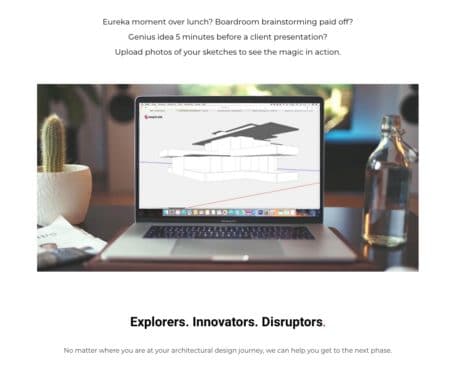


Reader Comments
Comments for this story are closed